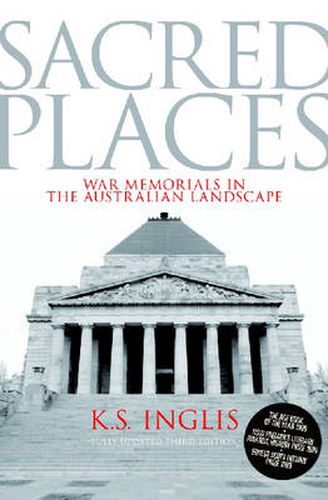Readings Newsletter
Become a Readings Member to make your shopping experience even easier.
Sign in or sign up for free!
You’re not far away from qualifying for FREE standard shipping within Australia
You’ve qualified for FREE standard shipping within Australia
The cart is loading…






Distinguished historian Ken Inglis argues that Australian war memorials are the shrines of a civil religion.
Memorials to Australian participation in wars abound in our landscape. From Melbourne’s huge Shrine of Remembrance to the modest marble soldier, obelisk or memorial hall in suburb and country town, they mourn and honour Australians who have served and died for their country. Surprisingly, they have largely escaped scrutiny. Ken Inglis argues that the imagery, rituals and rhetoric generated around memorials constitute a civil religion, a cult of ANZAC.
Sacred Places traces three elements which converged to create the cult- the special place of war in the European mind when nationalism was at its zenith; the colonial condition; and the death of so many young men in distant battle, which impelled the bereaved to make substitutes for the graves of which history had deprived them.
The ‘war memorial movement’ attracted conflict as well as commitment. Inglis looks at uneasy acceptance, even rejection, of the cult by socialists, pacifists, feminists and some Christians, and at its virtual exclusion of Aborigines. He suggests that between 1918 and 1939 the making, dedication and use of memorials enhanced the power of the right in Australian public life.
Finally, he examines a paradox. Why, as Australia’s wars recede in public and private memory, and as a once British Australia becomes multicultural, have the memorials and what they stand for become more cherished than ever?
Sacred Places spans war, religion, politics, language and the visual arts. Ken Inglis has distilled new cultural understandings from a familiar landscape.
$9.00 standard shipping within Australia
FREE standard shipping within Australia for orders over $100.00
Express & International shipping calculated at checkout
Distinguished historian Ken Inglis argues that Australian war memorials are the shrines of a civil religion.
Memorials to Australian participation in wars abound in our landscape. From Melbourne’s huge Shrine of Remembrance to the modest marble soldier, obelisk or memorial hall in suburb and country town, they mourn and honour Australians who have served and died for their country. Surprisingly, they have largely escaped scrutiny. Ken Inglis argues that the imagery, rituals and rhetoric generated around memorials constitute a civil religion, a cult of ANZAC.
Sacred Places traces three elements which converged to create the cult- the special place of war in the European mind when nationalism was at its zenith; the colonial condition; and the death of so many young men in distant battle, which impelled the bereaved to make substitutes for the graves of which history had deprived them.
The ‘war memorial movement’ attracted conflict as well as commitment. Inglis looks at uneasy acceptance, even rejection, of the cult by socialists, pacifists, feminists and some Christians, and at its virtual exclusion of Aborigines. He suggests that between 1918 and 1939 the making, dedication and use of memorials enhanced the power of the right in Australian public life.
Finally, he examines a paradox. Why, as Australia’s wars recede in public and private memory, and as a once British Australia becomes multicultural, have the memorials and what they stand for become more cherished than ever?
Sacred Places spans war, religion, politics, language and the visual arts. Ken Inglis has distilled new cultural understandings from a familiar landscape.